ВУЗ: Казахская Национальная Академия Искусств им. Т. Жургенова
Категория: Книга
Дисциплина: Не указана
Добавлен: 03.02.2019
Просмотров: 17246
Скачиваний: 51
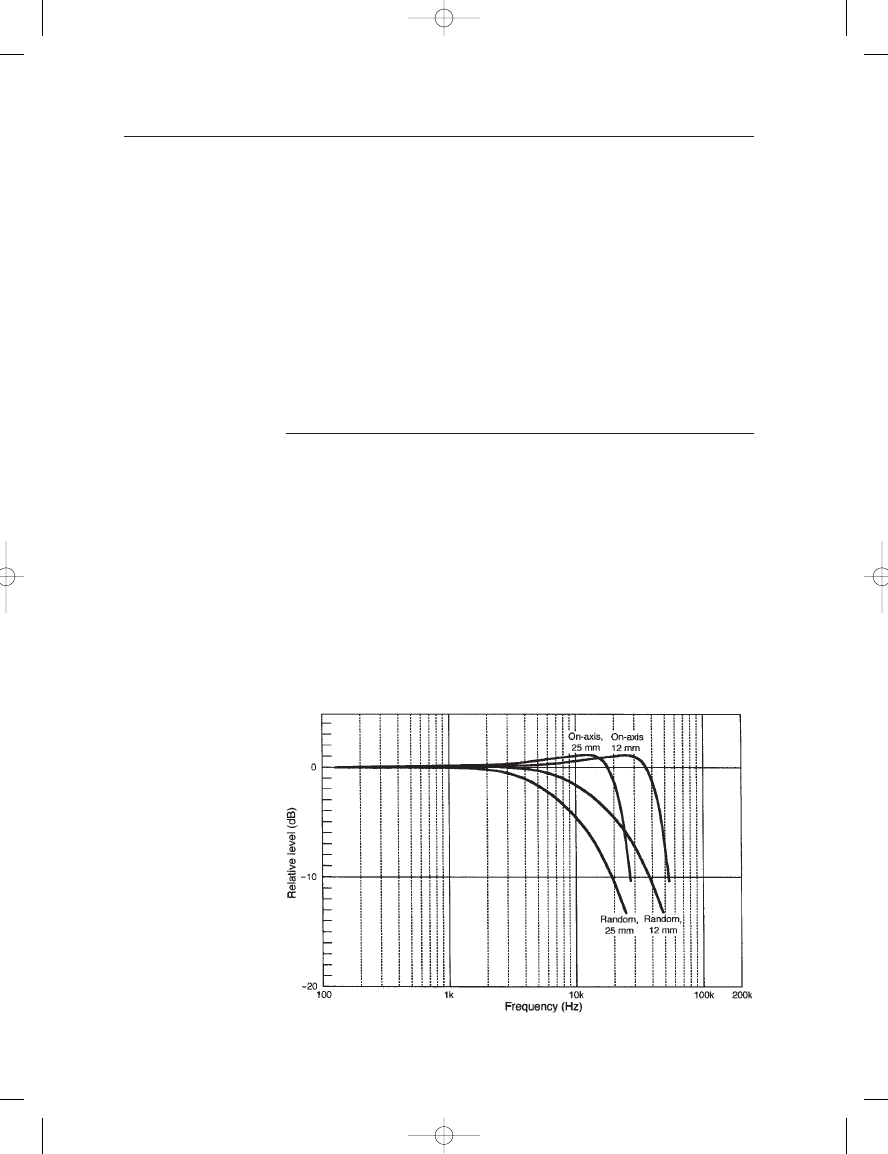
and backplate, which causes the diaphragm to move slightly farther
away from the backplate.
Regarding the output stage of the microphone’s built-in preamplifier,
the typical electrical output impedance is in the range of 50–200 ohms.
The output is normally balanced, either with a transformer or by bal-
anced solid-state output circuitry, to ensure interference-free operation
over long transmission paths downstream. The electrical load normally
seen by the microphone preamplifier is in the range of 1500–3000 ohms,
which approximates essentially an unloaded condition if the driving
source has a low impedance. Microphone wiring runs with low capaci-
tance cable may extend up to 200 m with negligible effect on response.
ON-AXIS VERSUS RANDOM INCIDENCE RESPONSE:
GRIDS, BAFFLES, AND NOSE CONES
As we saw in Figure 2–14, a free progressive plane wave arriving along
the primary axis of a cylinder or a sphere shows a considerable rise in
HF response. For the cylinder, the maximum on-axis rise will be 10 dB
relative to the response at 90
; by comparison, the sphere produces only
a 6 dB on-axis rise. In both cases, the response at 90
is very nearly flat
and, in fact, approximates the integrated response of the microphone in
a random sound field.
In the design of pressure microphones for both instrumentation and
recording the diffuse random field. The smaller the diameter of the obsta-
cle, the higher in frequency the divergence between random and on-axis
response, as shown in Figure 3–11. Here, the microphones have been
designed for essentially flat on-axis response.
3: The Pressure Microphone
33
FIGURE 3–11
Typical on-axis and
random response of 12 mm
(05 in) and 25 mm (1 in)
pressure microphones.
Earg_03.qxd 14/9/04 2:37 PM Page 33
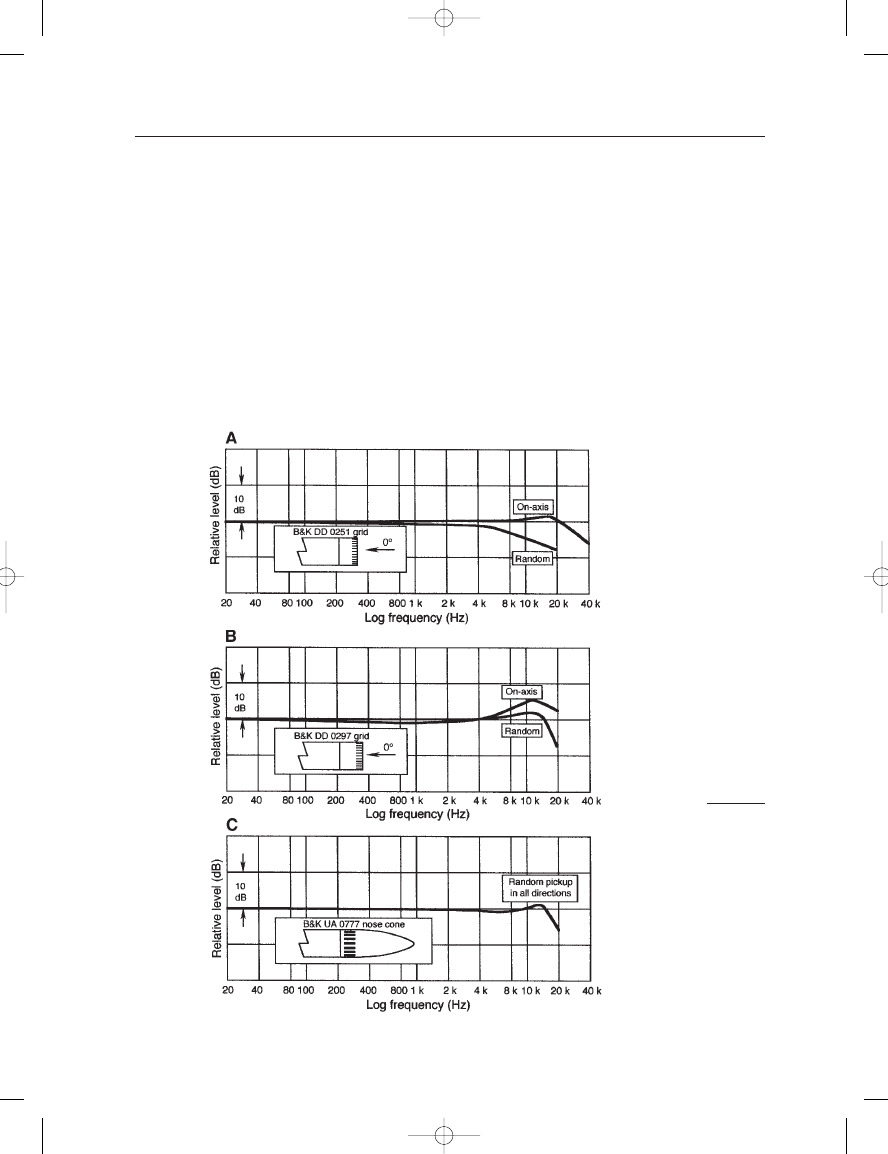
Figure 3–12 shows how a Brüel & Kjaer 4000 series omnidirectional
microphone can be modified in HF response by changing the protective
grid. The data shown at A is for the normal version of the microphone,
with flat on-axis response (
6 dB at 40 kHz) and rolled-off random inci-
dence response. When the normal grid is replaced with an alternate
grid that produces less diaphragm damping, the response in panel B is
produced. Here, the random incidence response is flat to 15 kHz and the
on-axis response exhibits a HF peak of about 6 dB.
The same microphone, with its normal grid replaced by a nose cone
baffle providing indirect access to the diaphragm, produces the response
shown at C for all directions of sound incidence.
The Neumann M50 microphone, designed during the mid-1900s,
consists of a 12 mm diameter capacitor element mounted on a sphere
THE MICROPHONE BOOK
34
FIGURE 3–12
Microphones designed
for specific pickup
characteristic: flat on-axis
response with rolled-off
random incidence response
(A); flat random incidence
with peaked response
on-axis (B); use of a special
nose cone baffle to produce
random incidence response
in all pickup directions (C).
(Data after Brüel and Kjaer,
1977.)
Earg_03.qxd 14/9/04 2:37 PM Page 34
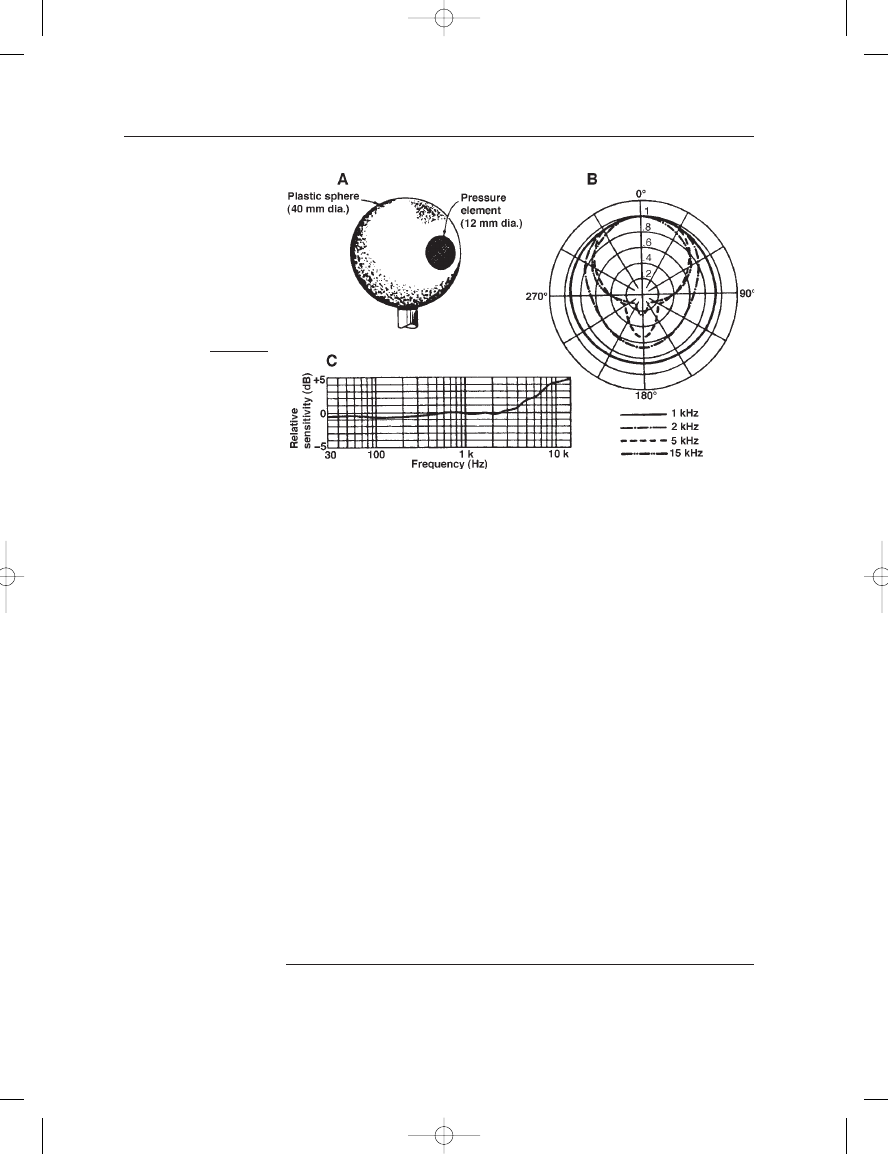
approximately 40 mm in diameter, approximating the spherical response
shown in Figure 2–14 for a diameter/wavelength corresponding to about
8200 Hz. Note the very close agreement between the on-axis response of
the M50 (Figure 3–13) and the data shown in Figure 2–14, when the
normalized unity value on the frequency axis is equated to 8200 Hz.
The M50 exhibits a flat diffuse field response but depends on the
sphere to give added HF presence to signals arriving on-axis. This micro-
phone has never lost its popularity with classical recording engineers and
often is used in the transition zone between the direct and reverberant
fields for added presence at high frequencies.
The Sennheiser MKH20, a flat on-axis pressure microphone, can be
converted to essentially flat random incidence response by engaging an
internal electrical HF shelving boost. It also can be given preferential on-
axis directivity by the addition of a small rubber ring mounted at the end
of the microphone. Details are shown in Figure 3–14. (The Sennheiser
MKH20 employs a radio frequency signal conversion system, which we
will discuss in Chapter 8. In terms of directional response, RF capacitor
microphones have the same characteristics as the other capacitor models
discussed in this chapter.)
Overall, the effects of diffraction and off-axis wave interference at
the diaphragm of a capacitor pressure microphone placed at the end of
a 21 mm diameter body produces the polar response versus frequency as
shown in Figure 3–15.
TYPICAL CAPACITOR PRESSURE MICROPHONE
NOISE SPECTRA
The capacitor pressure microphone represents a careful balance of tech-
nical attributes. It reached an advanced level of overall performance
3: The Pressure Microphone
35
FIGURE 3–13
Neumann M50 data,
including sketch of
capacitor capsule mounting
(A); polar response (B); and
on-axis frequency response
(C). (Figure courtesy
Neumann/USA.)
Earg_03.qxd 14/9/04 2:37 PM Page 35
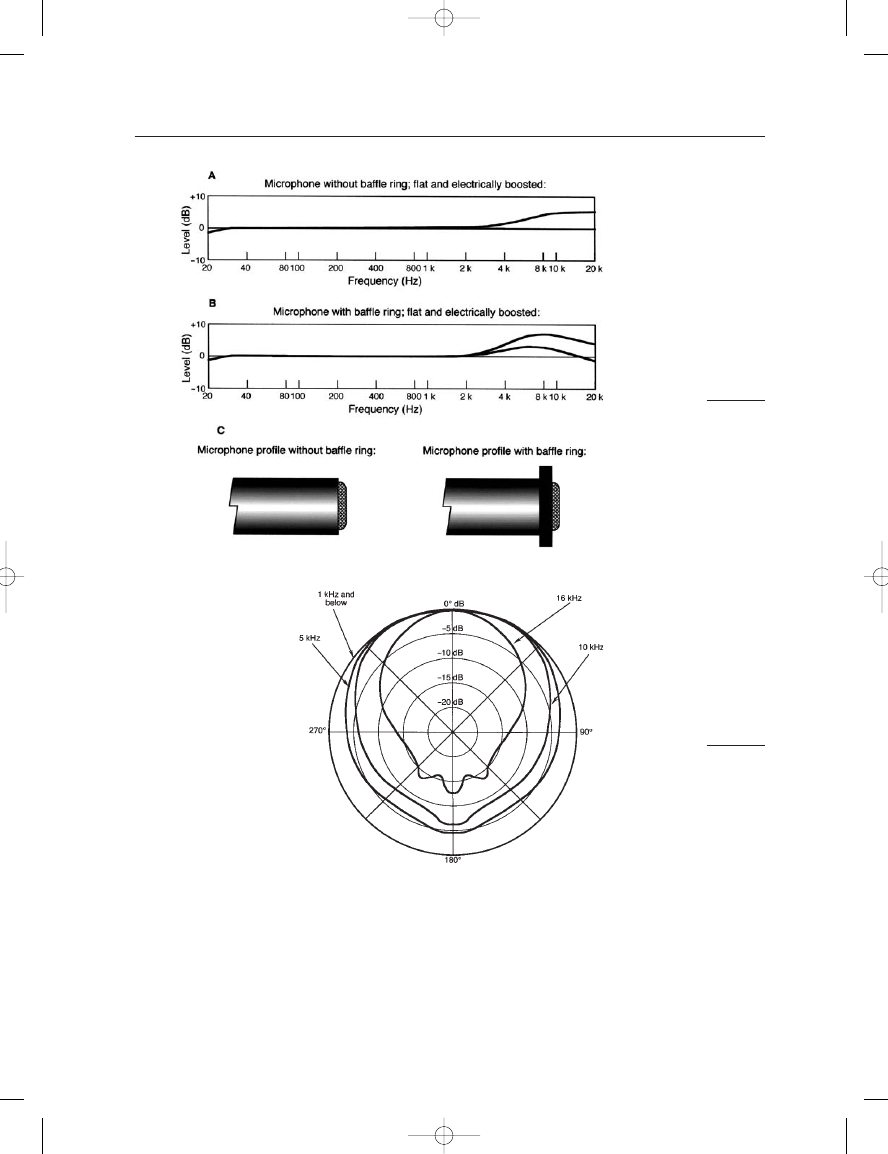
THE MICROPHONE BOOK
36
FIGURE 3–15
Set of polar curves for
a pressure microphone
placed at the end of a
21 mm diameter cylinder,
exhibiting narrowing of
response patterns at HF.
(Data after Boré, 1989.)
during the middle 1980s, and today’s many models invariably represent
different “operating points” among the variables of low noise, distortion
at high levels, bandwidth extension, and polar pattern control.
With the coming of digital recording, the self-noise of a capacitor
capsule and its associated preamplifier have come under close scrutiny,
since the effective noise floor of the Compact Disc and other higher
FIGURE 3–14
Sennheiser MKH20 data:
response with and without
baffle ring (A); response
with and without baffle
ring, electrically boosted at
HF (B); profiles of
microphone with and
without baffle ring (C).
(Data courtesy Sennheiser.)
Earg_03.qxd 14/9/04 2:37 PM Page 36
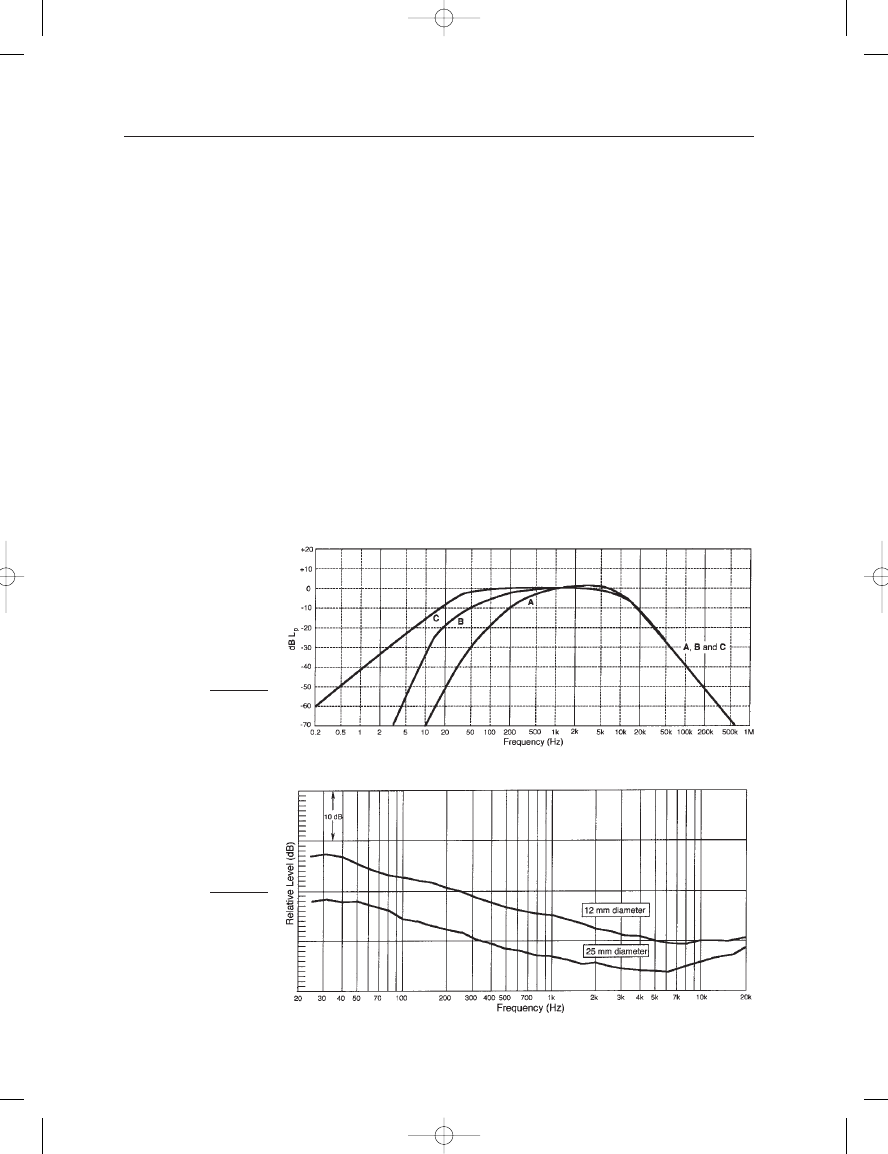
density formats is vastly lower than that of the long-playing stereo disc.
Microphone noise levels that were acceptable in the predigital era may
not be acceptable today. Over the years, we have seen the weighted noise
floors of studio-quality capacitor microphones drop by 10–12 dB.
The self-noise floor of a capacitor microphone is normally weighted
according to the A curve shown in Figure 3–16 and stated as an equiva-
lent acoustical rating. For example, a noise rating of 10 dB(A) indicates
that the noise floor of the microphone is approximately equivalent to
that which a theoretically perfect microphone would pick up if it were
operating in an actual acoustical space that had a residual noise rating of
10 dB(A), or its equivalent value of NC 10.
These matters are discussed in detail in Chapter 7, which is devoted
to microphone measurements; here, we intend only to detail the spectral
nature of the noise itself.
Figure 3–17 shows the composite one-third octave noise spectra
of a preamplifier with input capacitances equivalent to 25 mm (1in)
and 12 mm (0.5 in) instrumentation microphones. Note that as the
diaphragm diameter decreases by one half the noise floor rises approxi-
mately 6 dB. However, as a tradeoff of performance attributes, each
3: The Pressure Microphone
37
FIGURE 3–16
Standard weighting
curves for acoustical noise
measurements.
FIGURE 3–17
One-third octave noise
spectra at the output of a
microphone preamplifier
with input loaded by
capacitors equivalent to
25 mm and 12 mm
diameter capsules.
Earg_03.qxd 14/9/04 2:37 PM Page 37